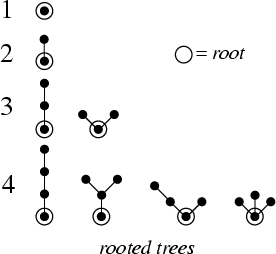|
|
|

A Tree with a special node called the ``Root'' or ``Eve.'' Denote the number of
rooted trees with ![]() nodes by
nodes by ![]() , then the Generating Function is
, then the Generating Function is
|
|
|
|
|
(1) |
![$\displaystyle x\mathop{\rm exp}\nolimits \left[{\,\sum_{r=1}^\infty {1\over r} T(x^r)}\right]$](r_1994.gif) |
(2) | ||
| (3) |
 |
(4) |
The number of rooted trees can also be calculated from the Recurrence Relation
 |
(5) |
See also Ordered Tree, Red-Black Tree, Weakly Binary Tree
References
Finch, S. ``Favorite Mathematical Constants.'' http://www.mathsoft.com/asolve/constant/otter/otter.html
Ruskey, F. ``Information on Rooted Trees.''
http://sue.csc.uvic.ca/~cos/inf/tree/RootedTree.html.
Sloane, N. J. A. Sequence
A000081/M1180
in ``An On-Line Version of the Encyclopedia of Integer Sequences.''
http://www.research.att.com/~njas/sequences/eisonline.html and Sloane, N. J. A. and Plouffe, S.
The Encyclopedia of Integer Sequences. San Diego: Academic Press, 1995.